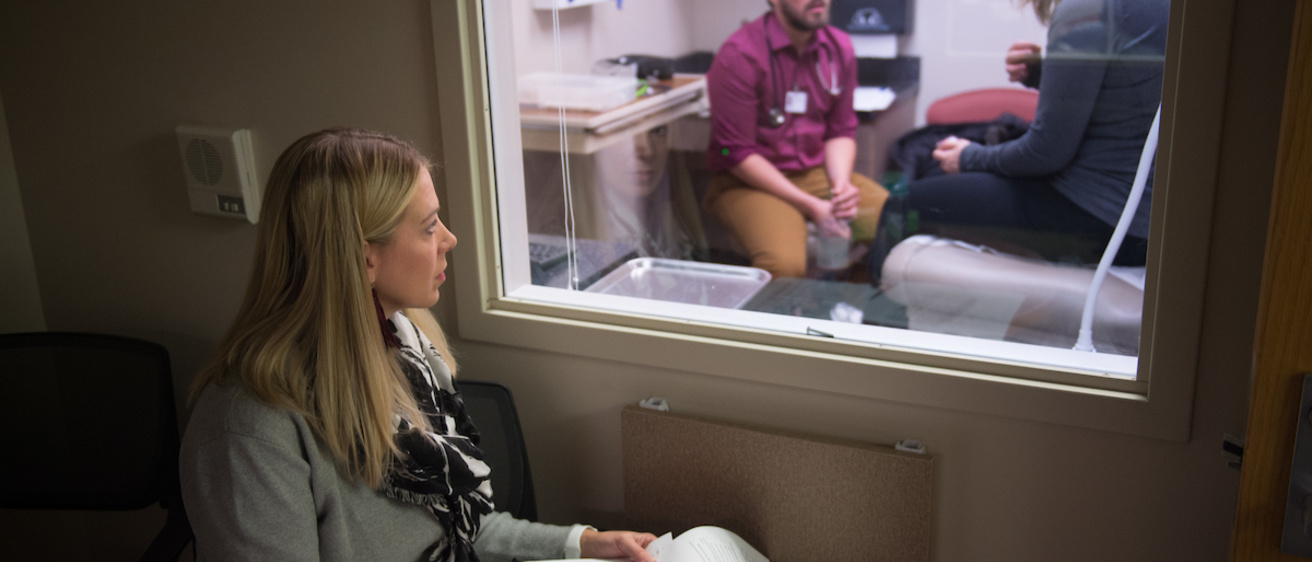The 16-year-old patient was clearly uncomfortable. Seated on the examination table, she twisted a strand of hair around her fingers and stared at the floor. Seated nearby was James Kinney, a University of Iowa nursing student whose job it would be to identify the teen’s hidden health issue.
Going into the exam, Kinney’s only information about his patient was her weight, height, blood pressure, and vaccination history. Kinney was understandably nervous about the challenge, but so too was his patient—and by design. She’s being played by UI theater student Catie Councell.
“Well, first, I want to reassure you that everything we discuss here today is confidential,” says Kinney, a Doctor of Nursing Practice (DNP) student in the UI College of Nursing. “There’s no judgment.”
“Um, OK,” says Councell, an MFA student in the UI Department of Theatre Arts, playing the role of Amanda Graziano, a soccer-playing 16-year-old with divorced parents and some confusion about her sexual orientation.
The exchange, and others like it, is part of a new collaboration between the UI College of Nursing and the Department of Theatre Arts that is helping students from both schools put classroom theory into practice. In the past few months, theater students have played the roles of a pregnant woman with preeclampsia and a little boy with pneumonia as part of regular nurse-training scenarios. In a recent scenario created specifically for students in the DNP program, theater students played teenagers with depression and substance abuse issues.
“Our goal with these exercises is to increase nursing students’ confidence and improve their skills when it comes to patient evaluations, especially difficult patient evaluations,” says Susan Van Cleve, professor and director of the UI’s Primary Care Pediatric Nurse Practitioner Program. “We want to make sure our students are competent.”
The opportunity to interact with actors who present authentic patient emotions and concerns in a supportive learning atmosphere is invaluable to nursing students, who are eager to put classroom theory into action. For theater students, the payoff is just as important: They are forced to come up with new lines in real time and with real people, not other trained actors.
“This is a real-life way for theater students to test their skills,” says Alan MacVey, professor and chair of the Department of Theatre Arts and director of the UI Division of Performing Arts. “They have to learn about specific medical symptoms and problems and then convincingly portray a person with those problems. It requires practice and rehearsal and engagement with someone who is not improvising. It is a very challenging situation, and it is not for everyone.”
MacVey, who also serves as co-chair of the UI Ad Hoc Arts Advancement Committee, says the collaboration between the two programs—one focused on medicine and the other on theater arts—is a good example of a broader effort to bring the arts into every classroom on campus. “We’re beginning to see some great connections and partnerships between departments,” he says. “I hope it will continue.”

For theater students, the joint effort also provides important experience in a type of work that could serve them well after graduation. Hospitals seek trained actors to portray patients in complex training exercises, and the pay is good. “This is an experiential opportunity for them to grow as a person, to learn about the medical world, and to expand their career options,” MacVey says.
For her role as a pregnant woman with preeclampsia, MFA student Tempestt Farrar of Raleigh, North Carolina, says she watched the PBS series Call the Midwife to learn about childbirth and some of the medical situations that could arise.
“The nursing professors always give me some background about the (role), but I also do a lot of improvisation,” said Farrar. “For example, sometimes, if (students) roll me over and they are a bit rough with me, I start to cry. Or if they hold my hand, I tell them that I appreciate it.”
During Kinney and Councell’s training scenario, things got off to a rocky start. After some initial questioning by Kinney, Councell’s teenager becomes visibly uncomfortable when Kinney asks about her sexual partners: She shifts on the table and looks at her smartphone. Kinney tries to comfort his patient and reassures her that confusion about sex and sexuality is normal for teens. In the end, Kinney makes the correct diagnosis, and his patient leaves with appropriate medical advice.
“I’m not 16, but I remember that age and the uncomfortableness of that age very well,” Councell tells Kinney after the exam scenario. “And from the moment you walked into that exam room, you were just so warm and personable. You didn’t make me feel like I was just another patient.”
Nursing professor Vanessa Kimm, who observed the exam scenario from a separate room via a one-way mirror, also offers words of praise. “That was perfect,” she says to the students. “Really great work, both of you.”
The nursing students had about 20 minutes to prepare before the training scenario began. One of the goals of the scenario was for students to expertly use a tool that helps health care workers assess teen health. The assessment starts with questions about the teen’s home life, education, and employment, then moves to questions about alcohol, drugs, and sexual activity.
DNP graduate student Jennifer Wittman of Iowa City, Iowa, says that she appreciated her training scenario—her theater student partner played the role of Kaitlin Pearson, a teenager who resorts to drinking alcohol and smoking marijuana to ease tensions at home—because it gave her the chance to make mistakes in a supportive atmosphere.
“When you’re learning, you’re bound to make some mistakes,” Wittman said. “This is a good place to make those mistakes, much better than to make them with a real patient. Plus, we get instant feedback, which is really important in terms of understanding how you could improve as a nurse.”
